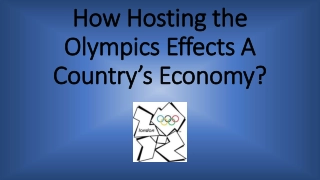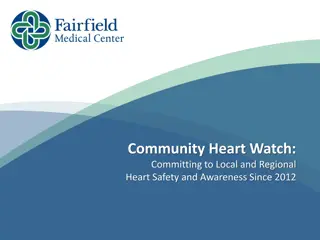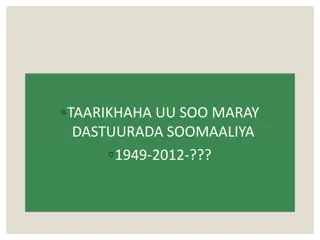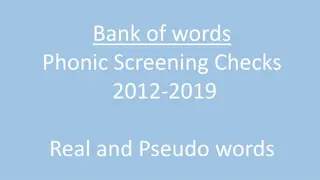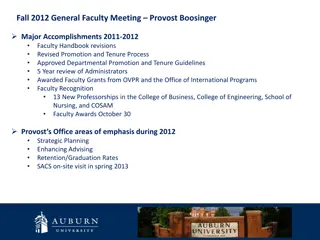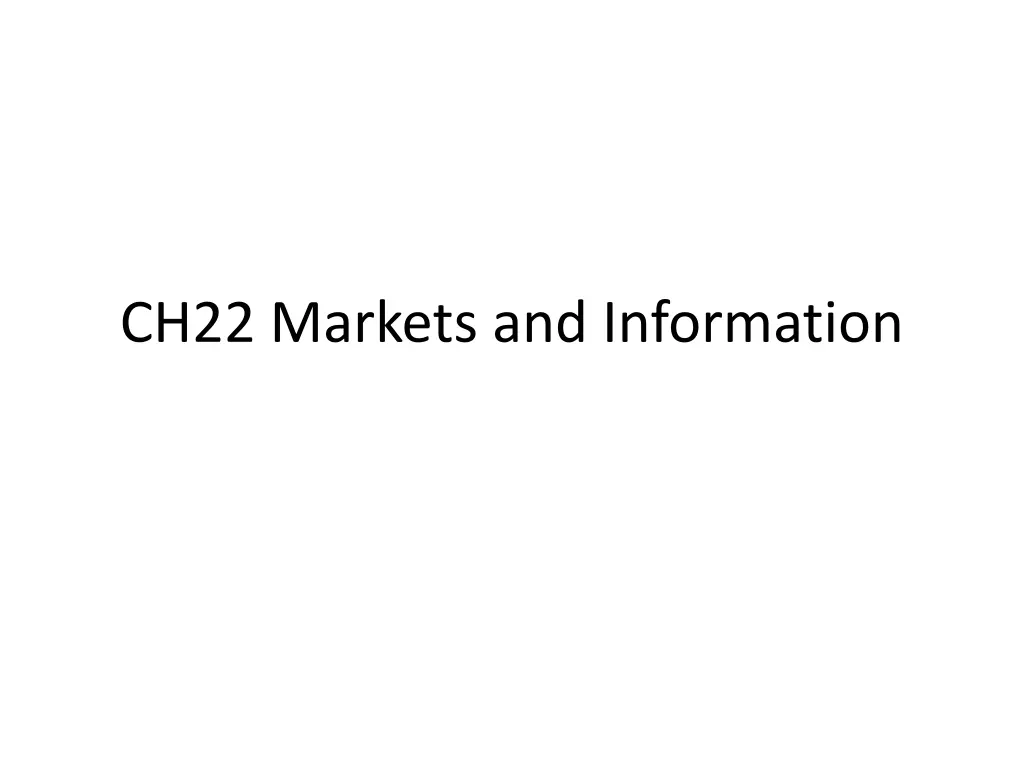
Markets and Information Dynamics
Explore the dynamics of markets and information in this insightful content, covering topics such as prediction markets, betting markets, aggregate beliefs, and more. Understand how individuals' expectations and decisions shape market outcomes, with examples like horse races and stock markets.
Download Presentation

Please find below an Image/Link to download the presentation.
The content on the website is provided AS IS for your information and personal use only. It may not be sold, licensed, or shared on other websites without obtaining consent from the author. If you encounter any issues during the download, it is possible that the publisher has removed the file from their server.
You are allowed to download the files provided on this website for personal or commercial use, subject to the condition that they are used lawfully. All files are the property of their respective owners.
The content on the website is provided AS IS for your information and personal use only. It may not be sold, licensed, or shared on other websites without obtaining consent from the author.
E N D
Presentation Transcript
Agenda 22.1 Markets with Exogenous Events 22.2 Horse Races, Betting, and Beliefs 22.3 Aggregate Beliefs and the \Wisdom of Crowds 22.4 Prediction Markets and Stock Markets 22.5 Markets with Endogenous Events 22.6 The Market for Lemons 22.7 Asymmetric Information in Other Markets 22.8 Signaling Quality 22.9 Quality Uncertainty On-Line: Reputation Systems and Other Mechanisms 22.10 Advanced Material: Wealth Dynamics in Markets
Basic concept Instituion any set of rules, conventions ,or mechanisms that synthesizes individual behavior across a population into an overall outcome. Markets , voting , and property rights Individuals expectations affect their behavior. Ex: Braess s Paradox ,information cascades and network effects
Basic concept Exogenous desirability means that a given alternative is inherently a good idea or a bad idea, regardless of how the individuals make their decisions. Ex : information cascade Endogenous desirability the desirability of an alternative depends on the actual decisions people make about it. Ex : Braess s Paradox and network effect(FAX)
Markets with Exogenous Events Prediction Markets aggregate opinions about events in settings where underlying events are exogenous-the probabilities of the events are not affected by the outcomes in the market. EX : Forecasting of a election(a contract that pays out if a Democrat wins in Iowa Electronic Markets) The price separate the buyer s and the seller s beliefs their beliefs are on opposite sides of the price, and we can view the price as an average of their beliefs.
Markets with Exogenous Events Betting Markets for sporting events such as horse races: what happens in the betting market does not affect the outcome of the sporting event Markets for stocks The financial capital that the company receives for its shares of stock affects its real investment decisions and thus the future value of the stock. Conclusion we can interpret the price of the asset being traded, whether it's a stock,a contract that pays out if a Democrat wins, or a betting ticket at a race-track, as a market prediction about some event.
22.2 Horse Races , Betting, and Beliefs Betting on a two-horse race, suppose that 1.Two horses : A and B, will run a race which one of them will win. 2.A bettor has w dollars and must bet all of this money ,and r represents the fraction of his wealth on horse A ,and 1-r represents the fraction will bet on horse B. 3. The bettor believes that horse A will win with probability a, and that horse B will win with probability b = 1-a.
Modeling Risk and Evaluating the Utility of Wealth The bet depends on more than the probability of A and B winning the race,it may also depend on two other factors. Odds, higher odds may be more attractive to bettor. And suppose that is the odds on horse A ,and is the odds on B. A bettor s reaction to risk Risk-averse people will bet so as to have some money left no matter which horse wins, by betting some money on each horse. The model of the bettor s attitude toward risk: the bettor evaluates a bet according to the expected value of the payoff on the bet. o o A B
Utility Function ( ) U (w)=w U ,means bettor s utility for wealth is exactly it s value. ,the bettor's utility increase from gaining a dollar is precisely equal to his utility decrease from losing a dollar. (w)=aw+b U 1/2 (w)=w U ,natural logarithm of the wealth (w)=ln(w) U
Example : A Fair gamble Suppose that a total wealth is w, a gamble in which he gains w dollars with probability , and loses w dollars with probability . So If utility function is ,so the gambleing would be indifferent between accepting and rejecting. 1 1 1 (2w)+ (0)= (2 ) 2 2 2 1 2 (w)=w U (w)=w U 1 2 + = = (0) ( ) U U w U w w If ,so he will reject the gamble 1 2 1 2 1 2 1 2 1 2 1 2 1 2 1 2 + = = (2w)+ (0)= (2 ) w 0 2 (w) U U w U w
Logarithmic Utility Suppose that utility function is the natural logarithm of the wealth , ,where w>0. Intuitive property the value of each additional dollar declines as wealth increases, but the value of doubling one's wealth is always the same. ln( ) w A similar argument would hold for any multiplicative increase or decrease in the bettor's wealth: the change in utility doesn't depend on the current wealth.
The Optimal Strategy : Betting Your Beliefs The expected utility after the bet is = As the third and fourth terms don t contain r , so the bettor's maximization problem is really just to maximize the first two terms. The derivative of the expression is , so r=a. Conclusion The bettor bets his beliefs
22.3 Aggregate Beliefs and the Wisdom of Crowds System with multiple bettors N bettors named 1,2,3 N Each bettors n believes A will win in a probability of ,and thus a probability of that B will win. Each bettors n has wealth ,total wealth is w=w +w +w +...+wN an = b 1 n a n wn 1 2 3 So the amount that bet on A is sum a w +a w +a w +...+a wN 1 1 2 2 3 3 N So the amount that bet on B is sum b w +b w +b w +...+b wN 1 1 2 2 3 3 N
The Odds Determined by the Race-Track Assume that no matter which horse wins the race-track pays out everything . If A win ,the total amount owed to the bettors is sum of their winning , which is equal to a w o +a w o +a w o +...+a w o =w 1 1 A 2 2 A 3 3 A N A N If B win, the total amount owed to the bettors is sum of their winning , which is equal to b w o +b w o +b w o +...+b w o B B B= w 1 1 2 2 3 3 N B N
Inverse odds on horse inverse odds on horse A 1 1 2 a w a w + w a w a w w 1 + +...+ =o 3 w 3 N N 2 A w Inverse odds on horse B 1 1 b w b w + w w f = w f + f + f +...+ a a b w b w w 1 + +...+ =o 3 w 3 N N 2 w 2 B for the share of total wealth held by bettor n, f =o N N a a f +b f +b f +...+b f =o N N b 1 1 o o 1 A B + = n n 1 1 1 2 2 3 3 A 1 1 1 2 2 3 3 B
State Price State Price Price of a dollar in the event that a certain future state of the world is reached is state price for that horse A wins is state price for that horse B wins State price are weighted averages of the individual s beliefs how much influence a bettor's beliefs have on the state price depends on how much of the aggregate wealth is controlled by that bettor -1 A -1 B =o =o A B
The Relationship to the Wisdom of Crowds The crowd at the racetrack determines the odds, or the state prices, and these odds are an average of the opinions in the crowd. The limitations of the wisdom of crowds First , it is important that opinion are independent. Non-independent opinion may lead to poor aggregate predictions Second , all beliefs are equally weighed. The more accuracy of state price depends on beliefs of these wealthy bettors are more accurate.
22.4 Prediction Markets and Stock Market State prices play a key role in both markets Prediction Markets Individuals trade claims to one-dollar return conditional on the occurrence of some event The price reflect an wealth-share weighted averaging of the beliefs of the participants in the market The market price Stock Markets a share of stock in a company offers a monetary amount that will vary depending on which of possibly many states occurs. = D a f +...+a Nf 1 1 N
State Price in the Stock Market Suppose that Two companies , named 1 and 2 Two possible state s1 (company 1 does well)and s2(company 2 does well ),and and state prices for states s1 and s2. In state s1 , company 1 worth 2 dollars and company 2 worth 1 dollars ; In state s2, company 1 worth 1 dollars and company 2 worth 2 dollars v1 and v2 are the price for the stock 1 and stock 2 State price : ,the solution is 1 1 2 v =2 +1 v =1 +2 1 denote the 2 2v -v = 1 3 2 1 2v -v 2 1 2 = 2 3 1 2
22.5 Markets with Endogenous Events Endogenous Events whether the events come true depends on the aggregate behavior of the individuals themselves. Ex: network effects and the market for lemons A important common theme is the notion of self-fulfilling expectations(Chapter 17) Asymmetric Infromation In many settings where buyers and sellers interact, one side of the market has better information about goods or services being traded than the other side does. Ex: eBay , health insurance ,stock market ,market for used car and so on.
22.6 The Market for Lemons Market for Lemons A used car that is particularly bad is called a lemon By economist George Akerlof who shared the 2001 Nobel Prize in Economics. Clearly articulate the underlying principle and its implications for how markets work - or, in some cases, how they fail to work.
Suppose that Two types of used cars good car and bad cars Each seller knows the quality of his or her own car , but buyers do not know. Sellers value good cars at 10 and bad car at 4 ,and buyers value good cars at 12 and a bad car at 6 A fraction g of used cars are good cars and hence a fraction 1-g are bad cars There are more buyers than used car
The Market with Symmetric Information The type of each car is known to everyone In this case ,every car could be sold. The Market with Asymmetric Information The type of each car is not known to buyers All car can only be traded at one price If the fraction of good cars in the population of used cars for sale is some number h , so the value that any buyer places on a used car is 12h+6(1-h)=6+6h
Characterizing the Self-Fulfilling Expectations Equilibria One candidate for an Equilibria equilibrium of this form is h=g the fraction of good car in the overall used-car population If p*=6+6g 10 ,or g 2/3, then seller will seller with good car and bad car would be happy to make a sale So if g 2/3 ,there is a self-fulfilling expectations equilibrium in which all cars are offered for sale If g<2/3,then p*<10,then owners of good cars would not be willing to sell, so they will keep them off the market meaning that h g So if g<2/3,h=g is not a self-fulfilling expectations equilibrium If h=0 (only bad cars are sold) ,then buyers willing to pay 6. So h=0 is a self-fulfilling expectations equilibrium
Complete Market Failure Suppose that Three types of used car: good , bad and lemons. Lemons are completely worthless to both buyers and sellers 1/3 of the cars are good, 1/3 are bad and 1/3 are lemons Sellers value good cars at 10, bad cars at 4, and lemons at 0 Buyers value good cars at 12, bad cars at 6, and lemons at 0. There are more buyers than there are used cars. Three candidates for an equilibrium (a). All cars are offered for sale (b). Only bad cars and lemons are offered for sale (c). only lemons are offered for sale , which represents the complete failure of the market
(a) If all cars to be on the market, then the expected value of a car to a buyer would be 12+6+0=6 3 As 6<10, so good cars would not be put on market , that means (a) is not a equilibrium. (b) If buyers expect bad car and lemons to be on market, then the expected value would be 6+0=3 2 As 3<4, so bad car would not be put on market, that means (b) is not a equilibrium (c)Finally, if only lemons for sold ,the expect value is 0,and this is the buyers are willing to pay , then the market will consist completely of lemons , it is a equilibrium.
Summary : Ingredients of the Market for Lemons Key features that led to market failure (i) The items that can be offered for sale have varying qualities. (ii) he buyers value the items of that quality at least as much as the sellers do - so with complete information, the market would succeed (iii) There is asymmetric information about the quality of the items (iv) Because of (iii), the items all must be sold for the same uniform price, and sellers will only put their items up for sale if they value them at or below this uniform price
22.7 Asymmetric Information in Other Markets The Labor Market, the people seeking jobs is the sellers ,and the companies is the buyers , basic assumptions: (i)There are different qualities of workers -productive and less productive workers (ii)There are different kinds of jobs at dierent levels of wages (iii)There is asymmetric information: a person has a better sense for how productive they are (iv)Because of (iii), a uniform wage will be offered, and only applicants who believe this wage acceptably values their skills will take the job.
Equilibria in the labor Market Suppose that Productive worker hired by the firm will generate $80,000 ,while each unproductive worker will generate $40,000 Each productive and unproductive worker could also produce an income of $55,000 and $25,000 respectively by being self-employed
If Half the workers in the population are of each type The expected revenue per employee will be 80,000+40,000 2 = 60,000 As 60,000>55,000 ,so both types of workers will be willing to accept the firm s offers and this is an equilibrium in which all workers are hired If the firm expects only unproductive workers on job market Only 40,000 per years for employee At this wage , only unproductive workers will accept jobs. If only of workers are productive and are unproductive The expected revenue per employee will be 1 4 3 4 + 40,000 50,000 = 80,000 As 50,000<55,000,the productive worker wouldn t accept the firm s offers. So there is no equilibrium- they have been driven out of the market by high frequency of unproductive workers
The Market for Insurance Ingredients of the market individuals in a given risk category can be more or less costly to insure, but the insurance company cannot reliably make these fine-grained distinctions. it is the buyers of health insurance, rather than the sellers, who have the additional information. For any risk category, the insurance company has to essentially charge a uniform price for the insurance the healthiest individuals in the group are being charged a price that is greater than the expected cost of providing care for them, and so they may be unwilling to buy insurance. So the average quality in the pool goes down ,the insurance must set higher price , which at last no one will buy insurance
22.8 Signaling Quality A kind of certification mechanism a way for a seller to provide a signal about the quality of the good that he or she is offering for sale. The overall warranties might be crucial for breaking down information asymmetries Signaling in the Used-car Market Offer a guarantee that a given car is a certified used car Offer a warranty promising that if the car needs to be repaired after the sale. Signaling in the labor Market Education
22.9 Quality Uncertainty On-Line: Reputation Systems and Other Mechanisms Reputation System Serve as a signal of seller quality Can reduce some of information asymmetries inherent in the site Challenges in creating a reputation system The reputational consequences of bad behavior can be mitigated on-line if there is an easy way to start over by simply registering a new identity on the site The seller can obtain identities with high reputation scores despite no genuine history of good behavior.
Ad Quality in Keyword-Based Advertising Ad quality Not just a proxy for the estimated rate of clicks the ad will get But based on a broader estimate of overall user satisfaction with the ad An unappealing ad based on a high bid could end up clogging the top slot on the page, generating very little revenue for the search engine because almost no one clicks on it. the ranking of an ad should not be based purely on the bid offered by the advertiser, but also on an estimate of the true click through rates
Advanced Material : Wealth Dynamics in Markets Markets impose a kind of natural selection favoring traders whose decisions are closest to optimal People with more accurate beliefs will do better in the market The wealth shifts toward them which increase their wealth share Their overall effect on the aggregate market price would increase which produce more accurate market price.
Bayesian Learning in a Market Beginning with a set of N possible hypotheses for the probabilities of horse A wins and horse B wins , which we will denote by 1 1 2 ( , ),( , a b a b ),...,( , ) a b 2 N N ( , ) nf a b Let be the prior probability on hypothesis ,and assume that is greater than zero Initial predicted probability of A winning is + a f a f n n nf +...+ a f 1 1 2 2 N N Suppose that T races are run ,and we observe a sequence S of outcome of these races, in which horse A wins a total of k times and horse B wins a total times l
The posterior posterior probability of the hypothesis ,conditional on the sequence S ,as follow ( , ) n n a b Pr[ |( , )] Pr[( , )| ] Pr[ ] S f f S a b f + f S a b = n n n a b S n n Pr[ |( , Pr[( |( , S )] S a b a b = n n n ))] ... + + Pr[ |( , )] Pr[( |( , ))] f S a b 1 1 f a b 1 2 2 2 N N N k n l n = n + + + k l k l k N l N ... 1 1 f a b f a b f a b 1 2 2 2 N After this sequence S of observed outcome , the learner s predicted probability on horse A is + + + Pr[( , )| ] a b Pr[( , )| ] ... S Pr[( , )| ] S a S a a b a a b 1 1 1 2 2 2 N N N The learner is Bayesian: as he observes outcome , he updates his predicted probability to Bayes Rule.
Convergence to the Correct Hypothesis Suppose that ,the ratios that compare the correct hypothesis to alternate hypothesis Pr[( [ ] Pr[( a ( , )=(a,b) a b 1 1 ( , ) a b 1 1 ( , ) a b )| ] ,b )| ] n n k l , a b S S f a b f a b = = R S 1 1 1 1 1 n k n l n n n n Log odds ratio ln( f f a a b b = + + [ ]) ln( ) ln( ) ln( ) R S k l 1 1 1 n n n n Divide both by total number of observations T, 1 1 ln( [ ]) ln( ) n n T T f T f a a b b k l = + + ln( ) ln( ) R S 1 1 1 T n n
When T goes infinity 1 lim ln( [ ]) n T T 1 T f f a a b b k T l = + + lim T ln( ) lim T ln( ) lim T ln( ) R S 1 1 1 T n n n a a b b = + 0 aln( )+bln( ) 1 1 n n =a ln(a )+b ln(b )-[a ln(a )+b ln(b )] 1 1 n n As is maximized when x=a So So Each So the probability on hypothesis is converging to one while the probability one each of the others is converging to zero. + ln( ) (1 x )ln(1 ) a a x 1 T lim T ln( [ ]) 0 R S n = + lim T [ ] R S n ( , ) a b 1 1
Convergence without a Correct Hypothesis If ,but the hypothesis is closer than other Realtive entropy ) ln( ) a b n n D a b a a = + ( , ) a b (a,b) ( , ) a b 1 1 1 1 ( , ) a b n n ln( ) [ ln( ) b + ( , )( , ln( )] b b a a b n n 1 T So = lim T ln( [ ]) ( , a b ) ( , ) a b 0 R S D D ( , ) a b ( , ) a b 1 1 n n n So we can draw same conclusion as before: that the posterior probability the learner places on converges to one ( , ) a b 1 1
Wealth Dynamic Suppose that start wealth share bettors m and n is and If horse A wins the ratio of the wealth share of m and n changes from to If horse B wins the ratio of the wealth share of m and n changes from to So after a sequence of races S in which A win k times and B wins L times ,then we end up with a ratio of wealth share that s equal to k f a b f a b nf mf ( ) t m ( ) t m t n f f a f m ( ) t n ( ) a f n ( ) t m f f ( ) t m t n b b f f m ( ) t n ( ) n l m m k n m l n n
Conclusion The wealth shares of the bettors evolve exactly like the posterior probabilities on hypotheses under Bayes' Rule if there is a unique bettor whose beliefs are closest in relative entropy to the correct probabilities (a,b), then in the limit the wealth share of this bettor will converge to 1.

